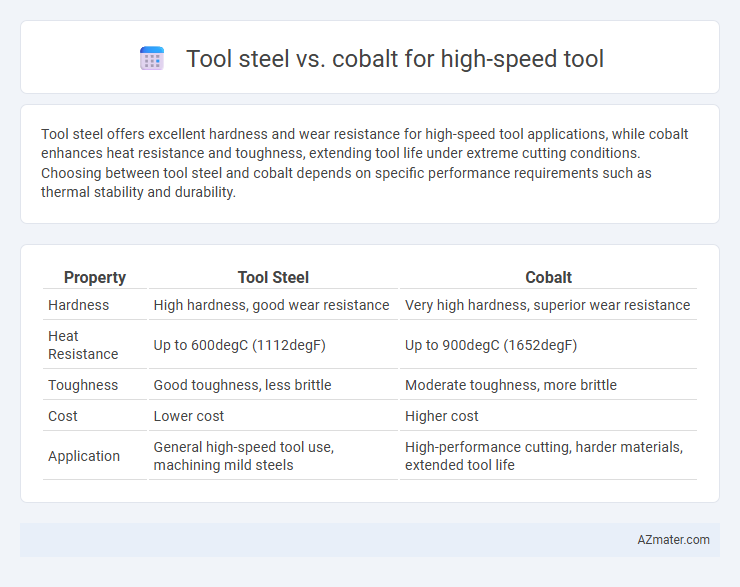Tool steel offers excellent hardness and wear resistance for high-speed tool applications, while cobalt enhances heat resistance and toughness, extending tool life under extreme cutting conditions. Choosing between tool steel and cobalt depends on specific performance requirements such as thermal stability and durability.
Table of Comparison
| Property | Tool Steel | Cobalt |
|---|---|---|
| Hardness | High hardness, good wear resistance | Very high hardness, superior wear resistance |
| Heat Resistance | Up to 600degC (1112degF) | Up to 900degC (1652degF) |
| Toughness | Good toughness, less brittle | Moderate toughness, more brittle |
| Cost | Lower cost | Higher cost |
| Application | General high-speed tool use, machining mild steels | High-performance cutting, harder materials, extended tool life |
Introduction to High-Speed Tool Materials
High-speed tool steels, such as M2 and M42 grades, offer excellent hardness and wear resistance critical for cutting applications involving high temperatures. Cobalt-based superalloys, notably used in high-speed tools, provide superior heat resistance and toughness, enhancing tool life under extreme thermal conditions. Selecting between tool steel and cobalt materials depends on balancing cutting speed requirements, durability, and temperature tolerance in advanced machining environments.
What is Tool Steel?
Tool steel is a specialized alloy designed for high hardness, wear resistance, and toughness, making it ideal for cutting and shaping metals at high speeds. Unlike cobalt, which enhances heat resistance and hardness when alloyed with other steels, tool steel itself contains elements like tungsten, molybdenum, and vanadium to maintain strength and durability under extreme conditions. Its precise composition allows it to withstand the intense heat and pressure generated during high-speed tooling operations.
What is Cobalt Steel?
Cobalt steel is a high-speed tool steel alloy containing a significant percentage of cobalt, typically around 5-8%, which enhances its hardness and heat resistance. This superior red hardness allows cobalt steel tools to maintain sharp cutting edges at elevated temperatures, making them ideal for high-speed machining of tough materials. Compared to standard tool steels, cobalt steel offers improved wear resistance and durability in demanding cutting applications.
Chemical Composition Comparison
Tool steel for high-speed tools typically contains significant amounts of tungsten (W), molybdenum (Mo), chromium (Cr), and vanadium (V) to enhance hardness, wear resistance, and heat resistance. Cobalt, often found in high-speed steels as a major alloying element (usually 5-12%), significantly improves red hardness and thermal stability by maintaining hardness at elevated temperatures. In contrast, pure cobalt tool materials have a simpler composition with predominantly cobalt content, allowing exceptional strength and wear resistance under high thermal stress compared to complex multi-element tool steels.
Hardness and Wear Resistance
Tool steel offers hardness typically ranging from 58 to 65 HRC, providing strong wear resistance suitable for general high-speed tooling applications. Cobalt alloys exhibit superior hardness often exceeding 65 HRC and enhanced wear resistance due to their higher red hardness, making them ideal for extreme cutting speeds and abrasive environments. The presence of cobalt in tool materials increases thermal stability and reduces deformation, significantly improving tool life under high-speed machining conditions.
Heat Resistance and Thermal Stability
Cobalt tool steels exhibit superior heat resistance and thermal stability compared to conventional tool steels, allowing them to maintain hardness and wear resistance at elevated temperatures up to 600degC. High-speed steels (HSS) often contain cobalt to enhance red hardness, ensuring consistent cutting performance under intense thermal stress. The increased cobalt content improves thermal conductivity and reduces thermal deformation, making cobalt-enriched HSS ideal for demanding high-speed machining applications.
Edge Retention and Performance
Tool steel and cobalt alloys are both favored for high-speed tool applications due to their outstanding edge retention and performance under extreme conditions. Cobalt-enhanced tool steels, such as M35 and M42, offer superior hardness and thermal stability, boosting cutting speed and wear resistance compared to conventional tool steels like A2 or O1. Edge retention in cobalt tools excels in high-temperature environments, maintaining sharpness longer and reducing tool replacement frequency in demanding machining operations.
Cost Analysis: Tool Steel vs Cobalt
Tool steel generally offers a lower initial cost compared to cobalt alloys, making it a more budget-friendly option for high-speed tooling applications. Cobalt, despite its higher expense, provides superior wear resistance and thermal stability, often resulting in longer tool life and reduced replacement frequency. Evaluating total cost of ownership, cobalt tools may deliver better value in demanding high-speed environments where extended tool performance justifies the premium price.
Best Applications for Each Material
Tool steel excels in high-speed tools requiring excellent wear resistance and toughness, making it ideal for cutting, drilling, and milling applications in moderate speed operations. Cobalt-based alloys outperform tool steel in extreme high-speed machining and applications involving high temperatures, such as aerospace turbine blade manufacturing and die casting, due to superior heat resistance and hardness retention. Selecting cobalt is optimal for prolonged tool life under thermal stress, while tool steel is preferred for cost-effective, versatile use in less demanding high-speed environments.
Choosing the Right Material for Your High-Speed Tool
Choosing the right material for high-speed tools involves evaluating tool steel and cobalt, both known for their hardness and wear resistance. Tool steel offers excellent toughness and heat resistance, making it suitable for general high-speed applications, while cobalt enhances red hardness and thermal stability, ideal for extreme cutting conditions. Prioritize cobalt alloys when machining tough metals or when maintaining cutting edge at high temperatures is critical, whereas tool steel remains cost-effective for less demanding tasks.

Infographic: Tool steel vs Cobalt for High-speed tool
 azmater.com
azmater.com